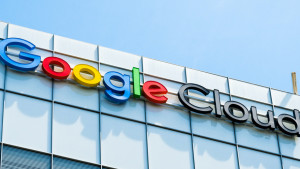- Adam Mansfield
- Reading Time: 5 minutes

Google Cloud kicked off its 9-week digital event, “Google Cloud Next ’20: On Air”, on July 14th with a keynote that heavily focused on providing value to its sought-after target – enterprises. If Google Cloud Next 2019 was Google Cloud’s official enterprise debut, 2020 is where they are expanding their product portfolio and building out their story to clearly convey their value proposition to enterprise executives. All of this is necessary given AWS and Microsoft are not only doing the same but already have a leg up, especially Microsoft, who has long-standing relationships in place with most enterprises already.
It’s clear that Google Cloud is continuing to find ways to approach enterprises and enhance their go-to-market strategy under the leadership of Thomas Kurian, Robert Enslin, and Kirsten Kliphouse. Over the past year, Google Cloud has sharpened their focus to emphasize Google’s key strengths and target specific issues that they believe are going to resonate with enterprises. They are hoping that their clear-cut messaging will give them the opportunity to make the pitch and ultimately land more enterprise customers while pulling business (and market share) away from AWS and Microsoft.
Here are the key topics and product announcements they covered in their keynote that Google Cloud will certainly be pitching to current and potential enterprise customers moving forward.
1. Data and Analytics with BigQuery Omni
In today’s digital transformation world, data and analytics are critical and top of mind for many enterprises. To address this concern and to further demonstrate their commitment to “multi-cloud”, Google Cloud announced BigQuery Omni, its multi-cloud analytics solution designed to enable enterprises and their users to access and analyze data across Google Cloud, AWS, and Azure.
Google Cloud’s pitch is that data does not ultimately need to move into Google Cloud so enterprises will not have to deal with those expensive egress fees. In other words, they’re going to make it flexible to allow enterprises to access, analyze, and unlock the value of their data across multiple cloud platforms to inform better business decisions. This is intended to empower enterprises with the ability to make that data more valuable to the business without worrying about where the data is sitting. This makes perfect sense as it clearly addresses a common and relevant pain point that enterprises are challenged with today.
2. Security and Privacy with Confidential Virtual Machines (VMs)
In response to security and privacy, which is another big focus for enterprises right now, Google Cloud announced the beta version of Confidential VMs. This is the first product to be released from what Google Cloud is calling the Confidential Computing Portfolio.
They created Confidential VMs to provide a solution that ensures that valuable data is encrypted not just at rest but also while in memory and in transit. While security and privacy are key concerns for all enterprises, Google Cloud is especially focusing on companies in regulated industries. They want to convey the message that if you go with Google Cloud, your data is secure, encrypted, and protected. It’s elevating Google Cloud’s pitch around security and their various innovations that focus on it. I expect more announcements over the next 9 weeks that are centered on the Confidential Computing Portfolio.
3. Industry-specific Solutions
Google Cloud highlighted multiple industries during the keynote including retail, healthcare, financial services, media, gaming, entertainment, industrial manufacturing, and the public sector. Their pitch is ultimately that they’re going to apply their machine learning capabilities to solve important business problems across these different industries. This makes perfect sense. It is always a good idea to take what you know and tailor it towards the audience you are looking to capture.
Not only will the application of Google Cloud’s machine learning capabilities help solve business problems, the promise is that it will deliver quick results at a much lower cost profile. Kurian also made it a point to mention that enterprises would not have to hire an army of data scientists anymore to get quick results. The promise of being able to accomplish your goal at a faster pace with less expense is very attractive.
If you’re in one of the industries listed, you can expect Google Cloud to approach you with a detailed pitch that addresses a common pain point in your sector. For example, demand forecasting is an important business problem in the retail industry. So, they are bringing that to bear within industry-specific solutions that use the power of their machine learning capabilities to help retailers do their demand forecasting.
This is incredibly valuable right now given the impact COVID-19 has had on retailers and the elevated importance of getting demand forecasting right. Google Cloud will also be pitching different solutions to financial services companies that are concerned about anti-money laundering and document processing.
By focusing on addressing known business challenges of various industries, Google Cloud is hoping to strengthen their position when they get the opportunity to pitch their solutions that use the power of Google’s well-regarded machine learning.
4. Workplace Productivity with Bundled G Suite and Meet
Google Cloud also made it a point to remind the audience that they officially had two billion users of G Suite at the end of 2019. Though they previously announced that 6 million businesses now pay for Google G Suite, they did not take time during the keynote to elaborate on how many are current paying customers.
They also put up a slide with some impressive Google Cloud customer logos but failed to break out how many of those customers are Google Cloud Platform (GCP), G Suite, and how many are both. That would also be a nice layer of detail that perhaps we’ll get in the future. If you are an enterprise that gets presented a similar logo slide during a sales pitch (as I am sure you will), you may want to challenge the Google Cloud sales rep to break that out for you.
A day after the keynote, they also announced that they were bundling video and chat in Gmail for business users. This new business version of Gmail incorporates more applications into a centralized location which will help equip Google Cloud to take Microsoft (Teams) and Slack head on.
While Google Cloud and G Suite have started to gain penetration within enterprises, convincing enterprises that already have access to Teams through the Office 365 subscription to make a change is one challenge that they are consistently coming up against. However, Google Cloud has taken a smart approach here in trying to differentiate enough to get over this very real hurdle. In terms of Slack, Google Cloud’s approach is doing whatever they can to keep Slack out of the enterprises that are interested in an alternative to Microsoft Teams.
UpperEdge Take
As a current or potential enterprise customer, it’s important to pay attention to Google Cloud’s announcements. Understanding their pitch can help you prepare specific questions for any conversations you have with them. Their overarching focus on industries is clever as is their emphasis on their “bread and butter” (machine learning) in their messaging.
Be prepared for Google Cloud to approach you with products that they claim can solve some of your biggest challenges and provide both quick results and economic benefits. When such promises are made, it is always good to ask the question, “What if they don’t solve our biggest challenges?” or “What if the results are not quick and the cost profile is higher than expected?” In other words, what assurances are they willing to make? My assumption is they will not be willing to provide a refund of any kind but perhaps they can get creative.
As Google Cloud continues to focus on developing products to help enterprises make their data more valuable and secure as well as tailor their solutions to meet industry-specific needs, it is important that potential customers ensure Google Cloud is appropriately focusing on the underlying contractual relationship as well. Key contractual terms and commitments that need to be in place include, but are certainly not limited to, long-term price protections as well as product and license flexibility to accommodate changes in demand over time.
Comment below, follow Adam Mansfield on Twitter @Adam_Mansfield_, find my other UpperEdge blogs and follow UpperEdge on Twitter and LinkedIn.
What to Read Next:
Related Blogs
How SAP’s Latest Announcements Impact Your Transformation Journey
Microsoft and Google Are Forcing Customers to Adopt AI at a Premium Price: What Customers Need to Know
Generative AI and AI Infrastructure from the Cloud Services Providers
About the Author
